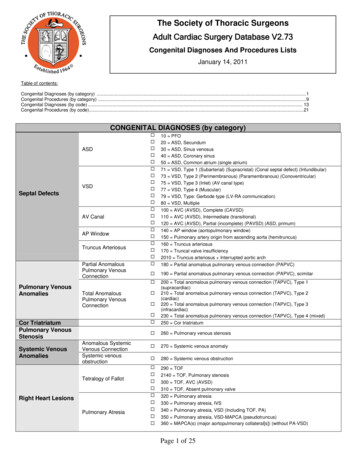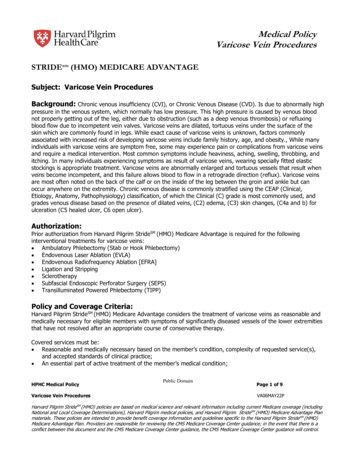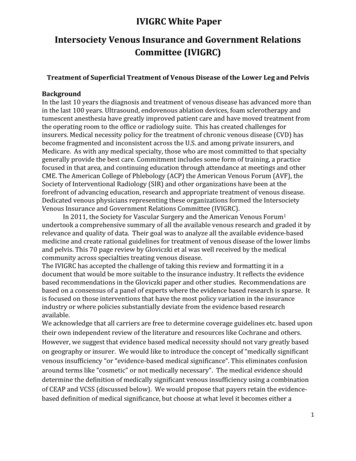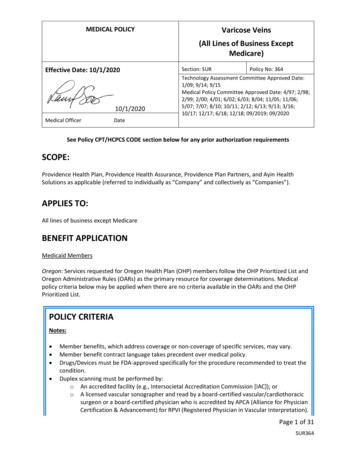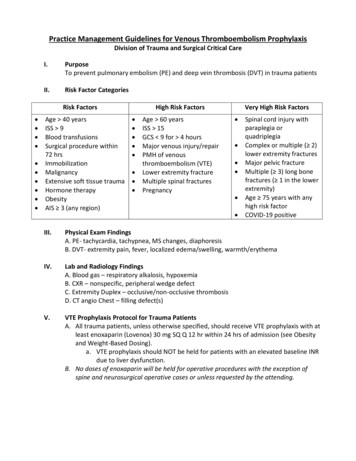
Transcription
Practice Management Guidelines for Venous Thromboembolism ProphylaxisDivision of Trauma and Surgical Critical CareI.PurposeTo prevent pulmonary embolism (PE) and deep vein thrombosis (DVT) in trauma patientsII.Risk Factor CategoriesRisk Factors Age 40 yearsISS 9Blood transfusionsSurgical procedure within72 hrsImmobilizationMalignancyExtensive soft tissue traumaHormone therapyObesityAIS 3 (any region)High Risk Factors Age 60 yearsISS 15GCS 9 for 4 hoursMajor venous injury/repairPMH of venousthromboembolism (VTE)Lower extremity fractureMultiple spinal fracturesPregnancyVery High Risk Factors Spinal cord injury withparaplegia orquadriplegiaComplex or multiple ( 2)lower extremity fracturesMajor pelvic fractureMultiple ( 3) long bonefractures ( 1 in the lowerextremity)Age 75 years with anyhigh risk factorCOVID-19 positiveIII.Physical Exam FindingsA. PE- tachycardia, tachypnea, MS changes, diaphoresisB. DVT- extremity pain, fever, localized edema/swelling, warmth/erythemaIV.Lab and Radiology FindingsA. Blood gas – respiratory alkalosis, hypoxemiaB. CXR – nonspecific, peripheral wedge defectC. Extremity Duplex – occlusive/non-occlusive thrombosisD. CT angio Chest – filling defect(s)V.VTE Prophylaxis Protocol for Trauma PatientsA. All trauma patients, unless otherwise specified, should receive VTE prophylaxis with atleast enoxaparin (Lovenox) 30 mg SQ Q 12 hr within 24 hrs of admission (see Obesityand Weight-Based Dosing).a. VTE prophylaxis should NOT be held for patients with an elevated baseline INRdue to liver dysfunction.B. No doses of enoxaparin will be held for operative procedures with the exception ofspine and neurosurgical operative cases or unless requested by the attending.
VI.Exceptions to VTE Prophylaxis ProtocolTraumatic brain and spinal cord injuryA. VTE prophylaxis will be initiated within 72 hrs of the injury/procedure for most intracranial hemorrhages and after craniotomy.B. Prophylaxis may be considered 24 hrs after admission for patients with mild TBI andthe following:a. GCS of 15 within 30 minutes of injuryb. Subdural or epidural hematoma 5mm and a repeat CT demonstratingstability.c. Contusion or intraventricular hemorrhage 2 cm (single lobe only) and arepeat CT demonstrating stability.C. Start VTE prophylaxis 24 hours after admission for patients with a minimal TBI (seeminimal TBI pathway)D. Patients with an intraspinal hematoma should have VTE prophylaxis started within 48hours of admission unless otherwise specified by the Ortho Spine or Neuro Spineteams.E. For patients requiring an operative spine intervention, VTE prophylaxis should be heldthe morning of surgery and may be resumed 24 hrs post-operatively unless otherwisespecified by the operating team.F. Enoxaparin is preferred in these patient populations, as well. However, patients withone of the above conditions and an ICP monitor, extraventricular drain, or spinal drainin place should receive heparin 5000 units Q 8 hrs. After removal of the ICP monitor ordrain, patients should be changed to enoxaparin 30 mg Q 12 hrs or appropriateweight-based dosing.Epidural or Paravertebral Block PlacementG. Enoxaparin will not be used 12 hours prior to epidural or paravertebral blockplacement, while the catheter is indwelling, or for 4 hours after removal.a. Heparin 5000 units Q 8 hrs and SCDs may be substituted for enoxaparin duringthe indwelling time.Renal ImpairmentH. For patients with a significant rise in SrCr ( 50%) or a creatinine clearance 30mL/min, enoxaparin may be renally adjusted to 30 mg daily or subcutaneous heparin5000 units Q 8 hrs may substituted for enoxaparin.a. In patients on renal replacement therapy, heparin 5000 units Q 8 hrs isrecommended over enoxaparin.Obesity and Weight-Based DosingCurrent patient weightEnoxaparin initial dose90 – 129 kg40 mg q12h130 – 179 kg60 mg q12h 180 kg80 mg q12h
I. If receiving subcutaneous heparin, patients with a BMI 40 kg/m2 and who do nothave an epidural catheter or paravertebral block in place, a higher dose of 7500 unitsq8h is recommended.VII.LMWH Anti-factor Xa (Anti-xa) Level MonitoringA. An Anti-xa level should be drawn in patients with the following characteristics:a. Weight 90 kgb. All patients in the very high risk factor groupB. Anti-xa level peaks should be drawn 4 hours after the administration of enoxaparin.These labs should be ordered after the third dose of enoxaparin.a. To order in Epic: LMW Heparin Assay (must time correctly)b. Goal peak is 0.2 to 0.4 IU/mL.i. If Anti-xa level is drawn appropriately and below the goal range,increase the dose to the next syringe size.c. Once the goal range is reached, no further monitoring neededVIII.Surveillancea. Routine lower extremity duplex ultrasound should be completed 72 hrs afteradmission and weekly thereafter in patients who are in the very high risk factor group.IX.IVC Filter PlacementA. Refer to IVC filter protocol (see Procedures Section athttp://www.traumaburn.com/mdprotocolstyle.htm)a. A prophylactic IVC filter may be considered in patients with paraplegia orquadriplegia; IVC, iliac, or femoral venous ligation/repair; severe pelvic fracturewith lower extremity long bone fracture; AIS head 3 with contraindication toanticoagulation; or high risk patients with contraindication, failure, orcomplications of anticoagulation.b. Indications for a therapeutic IVC filter include patients with known PE or lowerextremity DVT and contraindication, failure, or complication of anticoagulation,among other indications.
References:1. Rogers FB, Cipolle MD, Velmahos G, Rozycki G, Luchette FA. Practice management guidelinesfor the prevention of venous thromboembolism in trauma patients: the EAST practicemanagement guideline workgroup. J Trauma. 2002;53:142-164.2. Whiting PS, White-Dzuro GA, Greenberg SE, et al. Risk factors for deep venous thrombosisfollowing orthopedic trauma surgery: an analysis of 56,000 patients. Arch Trauma Res.2016;5(1):e32915.3. Geerts WH, Jay RM, Code KI, et al. A comparison of low-dose heparin with low-molecularweight-heparin as prophylaxis against venous thromboembolism after major trauma. N Engl JMed. 1996;335:701-707.4. Phelan HA, Wolf SE, Norwood SH, et al. A randomized, double-blinded, placebo-controlledpilot trial of anticoagulation in low-risk traumatic brain injury: the Delayed Versus EarlyEnoxaparin Prophylaxis I (DEEP I) study. J Trauma and Acute Care Surg. 2012;73:1434-1441.5. Koehler DM, Shipman J, Davidson MA, Guillamondegui O. Is early venous thromboembolismprophylaxis safe in trauma patients with intracranial hemorrhage. J Trauma. 2011;70:324-329.6. Christie S, Thibault-Halman G, Casha S. Acute pharmacological DVT prophylaxis after spinalcord injury. Journal of Neurotrauma. 2011;28:1509-1514.7. Clark NP. Low-molecular-weight heparin use in the obese, elderly, and in renal insufficiency.Thrombosis Research. 2008;123:S58-S61.8. Scholten DJ, Hoedema RM, Scholten SE. A comparison of two different prophylactic doseregimens of low-molecular weight heparin in bariatric surgery. Obesity Surgery.2002;12:19-24.9. Constantini TW, Min E, Box K, et al. Dose adjusting enoxaparin is necessary to achieveadequate venous thromboembolism prophylaxis in trauma patients. J Trauma Acute CareSurg. 2013;74(1):128-135.10. Chapman SA, Irwin ED, Reicks P, Beilman GJ. Non-weight based enoxaparin dosingsubtherapeutic in trauma patients. Journal of Surgical Research. 2016;201:181-187.11. Hegsted D, Gritsiouk Y, Schlesinger P, Gardiner S, Gubler KD. Utility of the risk assessmentprofile for risk stratification of venous thrombotic events for trauma patients. The AmericanJournal of Surgery. 2013;205(5):517-520.12. Droege ME, Mueller EW, Besl KM, et al. Effect of a dalteparin prophylaxis protocol using antifactor Xa concentrations on venous thromboembolism in high-risk trauma patients. J TraumaAcute Care Surg. 2014;76:450-456.13. Walker C, Sandmann E, Horyna T, Gales M. Increased enoxaparin dosing for venousthromboembolism prophylaxis in general trauma patients . Annals of Pharmacother.2017;51:323-331.14. Nunez J, Becher R, Rebo G, et al. Prospective evaluation of weight-based prophylacticenoxaparin dosing in critically ill trauma patients: adequacy of anti-xa levels is improved. TheAmerican Surgeon. 2015;81:605-609.15. Bickford A, Majercik S, Bledsoe J, et al. Weight-based enoxaparin dosing for venousthromboembolism prophylaxis in the obese trauma patient. The American Journal of Surgery.2013;206:847-852.16. Wang TF, Milligan PE, Wong CA, Deal EN, Thoelke MS, Gage BF: Efficacy and safety of highdose thromboprophylaxis in morbidly obese inpatients. Thrombosis and haemostasis. 2014;111(1):88-93.
17. Bethea A, Samanta D, Deshaies, et al. Determination of Optimal Weight-Based EnoxaparinDosing and Associated Clinical Factors for Achieving Therapeutic Anti-Xa Assays for DeepVenous Thrombosis Prophylaxis. J Am Coll Surg. 2019;229(3):295-304.18. Ha NB, Regal RE. Anticoagulation in Patients with Cirrhosis: Caught Between a Rock-Liver anda Hard Place. Ann Pharmacother. 2016;50(5):402-409.19. Chang R, Scerbo MH, Schmitt KM, et al. Early chemoprophylaxis is associated with decreasedvenous thromboembolism risk without concomitant increase in intraspinal hematomaexpansion after traumatic spinal cord injury. J trauma Acute Care Surg. 2017;83(6):1088-1094.20. Malas MB, Naazie IN, Elsayed N, Mathlouthi A, Marmor R, Clary B. Thromboembolism risk ofCOVID-19 is high and associated with a higher risk of mortality: A systematic review and metaanalysis-NC-ND license ). Publishedonline 2020. doi:10.1016/j.eclinm.2020.10063921. Kaufman E, Ong AW, Cipolle MD, et. al. The impact of COVID-19 infection on outcomes afterinjury in a state trauma system. J Trauma Acute Care Surg. 2021; 91(3):559-565.Updated August 2021Oscar Guillamondegui, MDBradley Dennis, MDLeanne Atchison, PharmDJennifer Beavers, PharmD
D. Patients with a n intraspinal hematoma should have VTE prophylaxis started within 48 hours of admission unless otherwise specified by the Ortho Spine or Neuro Spine teams. E. For patients requiring an operative spine intervention, VTE prophylaxis should be held the morning of surgery and may be resumed 24 hrs post-operatively unless otherwise
